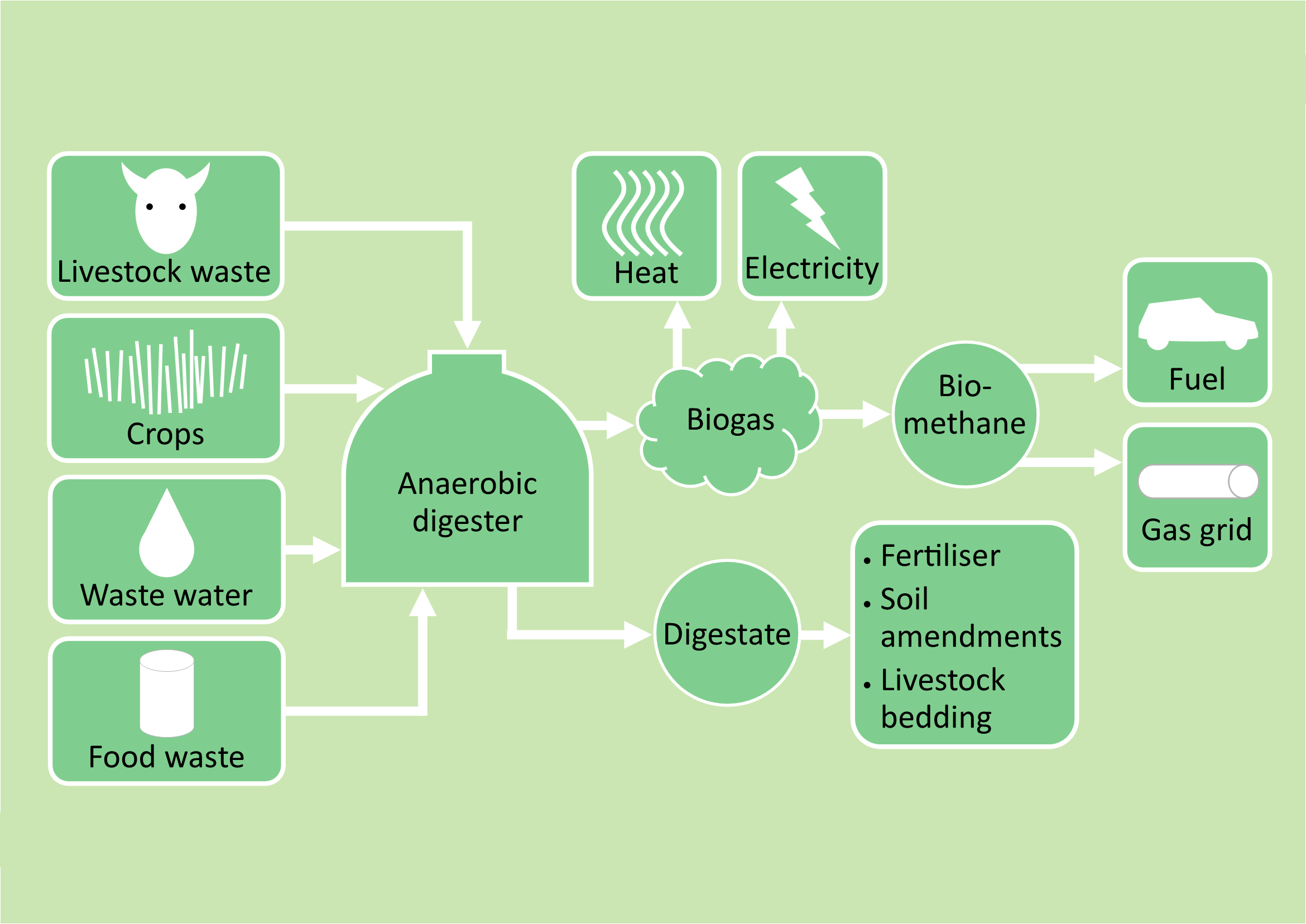Overview and purpose
Anaerobic digesters are enclosed structures where anaerobic breakdown of manure organic matter takes place, such as in the absence of oxygen. The anaerobic microorganisms convert the organic matter into biogas, which than can be captured and utilised for energy as a flammable gas.
Methane is the most commonly captured by-product from the digestion of organic matter, but carbon dioxide, hydrogen, hydrogen sulphide, nitrogen, and water vapour are also present.
Advantages of this type of organic matter treatment include the reduction of greenhouse gas emissions, the production of a renewable energy source, and a reduction in odours. However, the initial cost, level of labour, and continual management of the microorganism balance have prevented the widespread use of digesters. Recent financial support mechanisms in England have been aimed at readdressing this and are discussed further in the next section.
Anaerobic digestion process
Organic matter, such as livestock waste, crops, waste water and food waste, go into the anaerobic digester. This produces digestate or biogas. The digestate can be used as fertiliser, soil amendments or livestock bedding. The biogas can be used for heat and electricity, or converted to bio-methane, used in fuel or the gas grid.

Key points to consider
Policy ENV9 of the local plan supports renewable and low carbon energy facilities. Section 5.73 of the local plan states that where planning permission is required, individuals, farms, businesses and communities will be encouraged to bring forward their microgeneration projects and will be supported wherever possible. Paragraph 152 of the NPPF supports renewable and low carbon energy and associated infrastructure in order to assist the transition to a low carbon future in a changing climate. Read more of the national planning policy on the government website.
Within the Craven Climate Emergency Strategic Plan 2020 - 2030, it is stated under the ‘Low Carbon Waste’ section that the council aim to “build or support the building of anaerobic digestion facilities for food waste and/or agricultural products”.
Anaerobic digestion is particularly suited to organic material, and is commonly used for industrial effluent, wastewater and sewage sludge treatment. Anaerobic digestion can greatly reduce the amount of organic matter which might otherwise be destined to be dumped in landfills or burnt in incinerators.
Much of the significant increase in energy produced from anaerobic digestion over recent years in England is attributed to several support mechanisms designed to provide financial incentives to bridge the cost gap between conventional and renewable energy sources such as anaerobic digestion. In November 2021, Craven District Council received funding from the Government’s Community Renewal Fund to investigate carbon negative energy sources, including two potential anaerobic digestion sites in the Craven local plan area.
The differing sizes and types of installations may have differing requirements in terms of planning permission (see next section for further details).
The practical implications for planning officers and applicants
Planning permission is necessary for most anaerobic digestion installations in England. Small scale anaerobic digestors using only on-farm waste may be passed as Permitted Development, but it is recommended that the applicant contact the local authority to confirm this in the early stages of planning for this installation.
National and local planning policies highlighted in the previous section support renewable energy proposals such as anaerobic digesters on appropriate sites and subject to high environmental standards. Farmers can also use managed woodland waste as biomass for heating dairy and poultry units. This can be used in conjunction with an anaerobic digestion plant for kiln-drying biomass which is regarded as ‘waste’ if it would otherwise be shipped off-site.
All waste facilities are subject to additional controls through UK Environmental Protection legislation. These are administered by the Environment Agency and/or the local authority's Environmental Health department through licensing, consents and Environmental Permits. Anaerobic digestion plants normally require an Environmental Permit to regulate operational matters. However, the Environment Agency may instead require the applicant to register an Exemption in certain circumstances. The applicant is required to seek the advice of the Environment Agency alongside any planning application.
In practice, planning applications subject to these additional controls must be considered in land-use planning terms, as to whether they are capable of compliance. Visual impact, ecological harm, pollution risks, air and water quality, noise and odour are material considerations requiring mitigation at the planning stage (see the local plan’s Policy ENV7: Land and Air Quality). Local authorities work closely with the Environment Agency to ensure high standards of management and control.
Waste facilities including digesters fall under a number of regulations, including ‘Waste Permitting, the Industrial Emissions Directive (IED)’, and ‘Animal By-Product Regulations (ABPR)’, if the plant is accepting food waste. Permits are required for operating on-farm facilities using farm waste only (new applications from October 2018 and existing facilities from January 2019), and for operating AD as a recovery operation (this is also for new applications after October 2018 and existing facilities after January 2019). Both of these permits include the use of the resultant biogas. These permits are for facilities designed to take less than 100 tonnes a day.
Relevant Craven local plan policies and guidance
Policies ENV3: Good Design, ENV9: Renewable and Low Carbon Energy